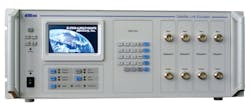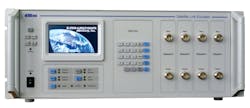Satellite-communications (satcom) systems count on dependable transmission and reception of microwave signals across the vast distances of space, or at least to and from orbiting satellites. Testing such systems is no trivial matter, since it involves including the effects of propagation and phase shifting across those distances. But the SLE900 Satellite Link Emulator line from dBm Corp. makes such satcom system testing possible at both intermediate frequencies (IFs) and microwave frequencies (using optional frequency converters) by means of advanced analog and digital signal processing.
The SLE900 series consists of three models: the SLE9072, with a 72-MHz-wide IF centered at 70 or 140 MHz; the SLE9125, with a 125-MHz-wide IF centered at 140 MHz; and the SLE9250, with a 250-MHz-wide IF centered at 1200 MHz. Optional tunable internal frequency up/downconverters can also be installed for L/S-band operation from 800 to 2700 MHz.
The SLE900 series of satcom emulators (see figure), which are also useful for testing aircraft communications systems, blend the best of analog and digital signal processing to achieve desired signal-modifying effects. An IF input signal is first passed through an in-phase (I) and quadrature (Q) demodulator to reduce it to its I and Q signal components, and these baseband signals are then digitized by 12-b analog-to-digital converters (ADCs). Delay emulation is achieved in the digital realm, passing the digital signals through a first-in, first-out (FIFO) memory module. Digital signal processing (DSP) is used for additional signal impairments, such as the optional Rayleigh and Rician multipath fading and injection of additive white Gaussian noise (AWGN), which is useful for bit-error-rate (BER) testing.
The SLE900 Satellite Link Emulator series operates at satcom intermediate frequencies (IF) and features a large touchscreen display for ease of control.
Once the desired impairments have been achieved in these digital I and Q signal components, they are applied to high-resolution (16-b) digital-to-analog converters (DACs) for their return to the analog realm. The analog I and Q signal components are “recombined” in a broadband I/Q modulator; a frequency-synthesized local oscillator (LO) is used to create frequency offsets and phase shifts as the I/Q signals are translated back to IF. At that stage, filters are used to remove the LO signals and other spurious content, and a variable attenuation provides emulation of path loss and flat (with frequency) fading.
The SLE900 Satellite Link Emulator series instruments can be configured with 1, 2, 3, or 4 independent channels, with the I/Q demodulation/modulation process applied separately to each channel. The emulators can effect quite a range of signal impairments as might be exhibited by a satcom system, including propagation delays, flat fading, path loss, phase shifts, and Doppler shifts. Propagation delays can be changed as part of the programmed control of the emulator, with phase continuity maintained during varying delay conditions.
The emulators can also deliver the time-varying delays found in satcom systems, which create frequency shifts and chip-period variations as caused by the movement of satellites or aircraft communications systems linked to the ground. The emulators can mimic the impairments imposed on communications signals from ground to satellite, satellite to satellite, and satellite to ground, as well as between the ground and an airborne vehicle.
In terms of performance, the satellite link emulators can handle 0-dBm maximum input power and deliver 0-dBm maximum output power at a 0-dB attenuation setting. Attenuation can be set from 0 to 74 dB with 0.1-dB resolution and with a slew rate of better than 40 dB/ms as needed for dynamic attenuation profiles. The emulators feature a Doppler range of ±3 MHz with 0.01-Hz resolution; the high accuracy of the Doppler setting is linked to the precision of each emulator’s internal 10-MHz reference oscillator.
Delay resolution can be adjusted with 0.1 ns for static settings and 0.5 ps for dynamic delay profiles. The emulators have a noise floor of typically -145 dBm/Hz and exhibit in-band spurious levels of better than -45 dBc for a 0-dBm input level and typically better than -50 dBc.
The SLE900 emulators are aided by an easy-to-use touchscreen color display and can be programmed using data files with virtually unlimited file size (only restricted by the capacity of the onboard flash memory of the instrument). Each instrument measures 17.625 x 7 x 21 in. and is available with a number of options. These include AWGN generation and six-path multipath fading (with Doppler spread of 0 to 12 kHz and delay range of 0 to 15 μs). In addition, optional frequency converters are available to extend the frequency range of the SLE900 satcom emulators through Ka-band frequencies.
Finally, the firm also offers SATGEN software, which can be used to program any required orbital and ground-station coordinates, as well as to generate paths between the two; it contains preprogrammed coordinates for a large number of popular satellite systems. SATGEN runs on any Windows®-based personal computer. The SLE900 also fully supports the Satellite Tool Kit (STK) software package from Analytical Graphics.
dBm Corp., 32A Spruce St., Oakland, NJ 07436; (201) 677-0008, FAX: (201) 677-9444, e-mail: [email protected], www.dbmcorp.com.
About the Author
Jack Browne
Technical Contributor
Jack Browne, Technical Contributor, has worked in technical publishing for over 30 years. He managed the content and production of three technical journals while at the American Institute of Physics, including Medical Physics and the Journal of Vacuum Science & Technology. He has been a Publisher and Editor for Penton Media, started the firm’s Wireless Symposium & Exhibition trade show in 1993, and currently serves as Technical Contributor for that company's Microwaves & RF magazine. Browne, who holds a BS in Mathematics from City College of New York and BA degrees in English and Philosophy from Fordham University, is a member of the IEEE.

